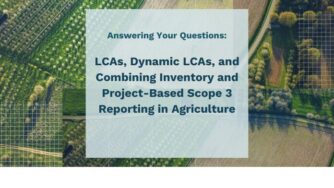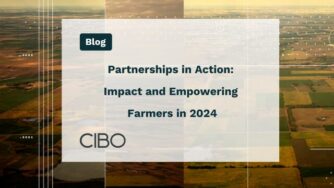At CIBO, we often talk about the importance of the science that underlies our applications, CIBO Enterprise and CIBO Grower. For example, one of the core services of the CIBO platform is crop and ecosystem modeling using the SALUS model (System Approach to Land Use Sustainability).
CIBO has an exclusive commercial license to SALUS, but we didn’t stop there. CIBO is perpetually validating and building out our robust modeling capability. Furthermore, we recognized a need in the industry to make the power of crop modeling available to customers, including those who don’t have a Ph.D.
Why Businesses and Farmers Need Crop Modeling
Applying crop modeling to sustainable supply chain management is a huge advantage in the fight against climate change. A reliable model provides a scalable way to quantify the impact that farming has on greenhouse gas (GHG) emissions and sequestration. Using CIBO’s unique implementation of SALUS, the CIBO platform can model:
- The current carbon footprint of a field, portfolio, or supply shed
- The carbon intensity (i.e., the amount of carbon equivalent emitted per bushel or kilogram) of crops grown (this feature coming soon to the CIBO user interface)
- What-if scenarios to see how implementing regenerative practices will change the carbon footprint or intensity
- How carbon footprint and carbon intensity have changed following a season, given practice changes and weather conditions, to determine the Scope 3 emissions reduction
- How yield may be affected under different conditions
Access to valuable modeling outputs allows businesses to effectively plan and track progress on their emissions reduction goals while spending less time and money on soil sampling. It’s a more efficient and cost-effective way to track Scope 3 emissions. The efficiencies created by a user-friendly modeling platform can translate to more dollars available to incentivize farmers to transition to regenerative ag, leading to better financial security for farmers and climate resilience for the enterprises that source from them.
Advantages of the SALUS Model
As CIBO co-founder Dr. Bruno Basso describes in his recent GreenBiz article, crop models that were once primarily applied in academia are now used in the business world. To understand why CIBO uses SALUS for this purpose, it helps to know a bit about the alternatives and the importance of a balanced approach in modeling:
Crop models have been around for four decades, although mostly in the academic research domain. With progress in agricultural science, computational power, and the availability of public datasets on soil and climate, models are finally being used to help stakeholders make more informed decisions.
Some models were developed to advance scientific knowledge and help provide answers and insights into complex mechanisms. These require many inputs that are not easily measurable and thus must be estimated by users. Such estimation increases the uncertainties of results. Other models are based on readily available inputs with the goal of solving problems and supporting stakeholders in their decision-making.
Models must have a balanced approach between the number and quality of input variables and the robustness in the simulation of complex processes and interactions. Unbalanced models tend to capture a high level of detail in some better-known processes, often neglecting details of less-understood processes of equal importance.
For example, it’s not helpful to have a detailed simulation of plant photosynthesis if the soil processes providing water and nutrients for the plant are not represented with the same level of detail. It’s not helpful to have a complex soil carbon model if it cannot reasonably simulate yields, root water, and nutrient uptake. The quality results depend on the least-represented process simulated in the model. The appropriateness or fitness of the model depends on how well the results it delivers answer the questions being asked.
Further, models need to be validated across soil, climate, and management conditions to build trust from the agricultural players who need them to scale results of practices to help adapt to and mitigate climate change.
SALUS meets these criteria. It is a validated model that has been the subject of over 20 years of testing around the globe. The model provides a balanced approach, with the ability to generate answers required by businesses facing climate change.
How CIBO Makes Crop Modeling Accessible to Businesses
While preserving the science, CIBO has built infrastructure that integrates with the SALUS model to make its capabilities accessible for solving ESG and business problems faced by companies with agriculture in the supply chain. The CIBO platform provides:
- Fast, reliable results at scale
- Insights that matter to the most pressing strategic business goals
- Integration with other powerful services that free up farmers to keep farming
Rapid Results
Running a crop model typically requires extensive amounts of time to gather inputs and run calculations, but CIBO’s scaled infrastructure provides results at the pace of business. By integrating SALUS with publicly available soil and weather data as well as remotely sensed and inferred practice history, CIBO has removed the need for users to spend hours or days gathering model inputs. We’ve then pre-run model calculations for every farm parcel across the United States.
Whether you want information on a single field or a supply shed, the results are immediately available and returned in moments. Our team ensures that the data is as up-to-date as possible so you can see changes as they happen. Time is not a limitation for CIBO users; run multiple scenarios as needed to make real-time and strategic decisions.
Insights You Can Use
The CIBO platform translates crop modeling results into usable business insights for companies that have ag in the supply chain. The mechanistic SALUS crop model allows you to forecast yield and carbon outcomes. Perform what-if analyses to determine how implementing regenerative practices would change the carbon footprint of a portfolio or the carbon intensity per bushel of yield. Math, science, or programming degree not required. CIBO’s user interface allows anyone to run scenarios without needing special skills or technical training.
Results can be easily exported to include in ESG reporting or to plan and design supply chain interventions that reduce Scope 3 emissions. The CIBO platform makes complex modeling accessible to every-day users so that sustainability planning and execution are backed by solid science.
Let Your Farmers Farm
Other greenhouse gas modeling platforms require farmers or their advisors to spend precious time inputting details about their management practices. CIBO has solved this problem by integrating the SALUS model with our remote sensing and practice inference engines.
CIBO’s remote sensing engine leverages satellite imagery and computer vision to determine historical and in-season practices. These include cash crop type, cover crop presence, planting dates, emergence, and tillage type.
The CIBO practice inference engine utilizes public and proprietary data to infer practices that computer vision is unable to determine (for example, fertilizer amount), or where available satellite imagery is incomplete or unreliable.
Integrating the SALUS model with CIBO’s remote sensing and practice inference engines means farmers don’t need to provide extensive practice history to get detailed model results. The practice history is remotely determined and plugged into the model, freeing up farmers to simply verify their practice history and then go back to doing the work they love, spending less time inputting data on their devices.
Conclusion
Reliable crop and ecosystem modeling are key to scaling regenerative agriculture. CIBO has integrated the robust science of the SALUS crop model into a platform that provides the speed, insights, and capabilities that businesses need to make widespread regenerative agriculture a reality.



